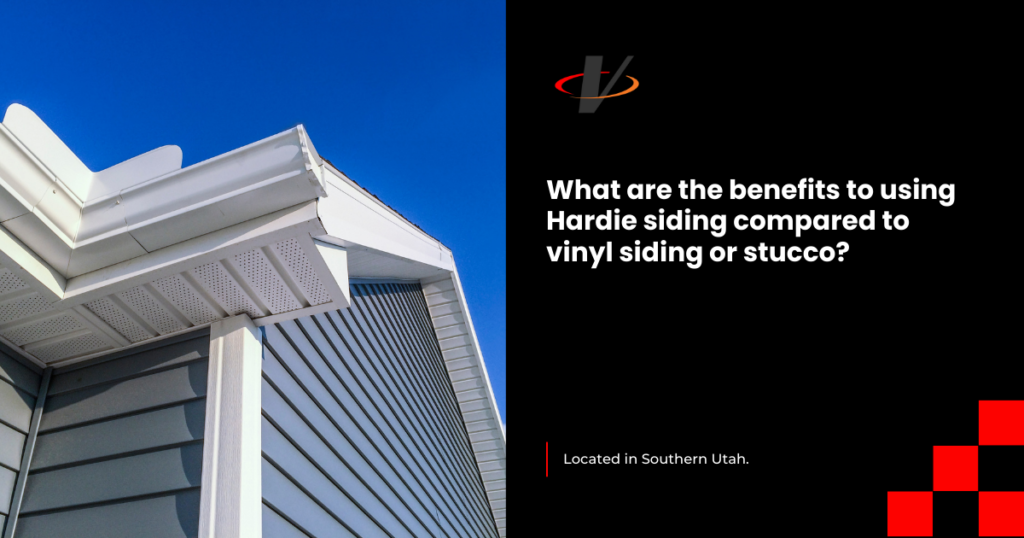
Comparing Hardie Siding, Vinyl Siding, and Stucco: Benefits and Considerations
When it comes to choosing the right exterior siding for your home, the decision can significantly impact both the aesthetics and durability of your property. Hardie siding, vinyl siding, and stucco are three popular options, each with its own set of benefits. In this guide, we’ll explore the advantages of each to help you make an informed choice.
Hardie Siding (Fiber Cement)
Durability:
Hardie siding, made from fiber cement, is renowned for its exceptional durability. It can withstand extreme weather conditions, including heavy rain, strong winds, and hail.
It is resistant to fire, termites, and rot, making it a long-lasting option for homeowners.
James Hardie – Benefits of Hardie Siding (https://www.jameshardie.com/why-hardie)
Aesthetic Appeal:
Hardie siding comes in a variety of styles, textures, and colors, allowing for a customized look that can mimic the appearance of wood, stucco, or other materials.
The color options are baked on, providing a long-lasting finish that resists fading and chipping.
Maintenance:
Requires minimal maintenance compared to wood siding. An occasional cleaning and periodic repainting can keep it looking new.
James Hardie – Maintenance Tips (https://www.jameshardie.com/why-hardie/best-practices/maintenance-tips)
Cost:
Generally more expensive upfront than vinyl siding but offers better long-term value due to its durability and low maintenance needs.
Vinyl Siding
Affordability:
Vinyl siding is one of the most cost-effective options available, making it a popular choice for budget-conscious homeowners.
It is lightweight and easy to install, which can further reduce labor costs.
HomeAdvisor – Vinyl Siding Cost Guide (https://www.homeadvisor.com/cost/siding/install-vinyl-siding/)
Low Maintenance:
Requires very little maintenance; periodic washing with a garden hose is usually sufficient to keep it clean.
Does not require painting or staining, reducing long-term upkeep costs.
Variety:
Available in a wide range of colors and styles, including options that mimic the look of wood grain and other materials.
Color is integral to the material, so it resists fading and scratches are less noticeable.
Energy Efficiency:
Insulated vinyl siding is available, which can improve your home’s energy efficiency by providing an extra layer of insulation.
Energy.gov – Vinyl Siding (https://www.energy.gov/energysaver/design/energy-efficient-home-design/vinyl-siding)
Durability:
While durable, vinyl siding can crack or become damaged in extreme temperatures or from impact, such as hail or windblown debris.
Stucco
Aesthetic Appeal:
Stucco offers a distinct, textured appearance that is especially popular in Southwestern and Mediterranean-style homes.
Can be customized with various textures and colors, providing a unique and elegant look.
Durability:
Properly installed and maintained stucco can last for decades. It is resistant to fire and pests.
Performs well in dry climates but can be susceptible to moisture damage in wet or humid environments.
The Spruce – Pros and Cons of Stucco Siding (https://www.thespruce.com/stucco-siding-pros-and-cons-1821968)
Energy Efficiency:
Stucco provides excellent insulation properties, helping to keep homes cooler in the summer and warmer in the winter.
Can be combined with additional insulation layers to enhance energy efficiency.
Maintenance:
Requires regular maintenance, including sealing and painting, to prevent cracks and moisture infiltration.
Repairs can be more complex and costly compared to other siding options.
Cost:
Generally more expensive than vinyl siding but can be comparable to or slightly less expensive than Hardie siding, depending on the complexity of the installation.
Conclusion
Choosing between Hardie siding, vinyl siding, and stucco depends on your specific needs, budget, and aesthetic preferences. Hardie siding offers unparalleled durability and a variety of styles but comes at a higher upfront cost. Vinyl siding is an affordable, low-maintenance option with a wide range of styles but may not be as durable in extreme conditions. Stucco provides a unique, textured look with good insulation properties but requires regular maintenance and is best suited for dry climates.
By considering the benefits and drawbacks of each siding option, you can make an informed decision that enhances the beauty, durability, and energy efficiency of your home.
References
James Hardie – Benefits of Hardie Siding (https://www.jameshardie.com/why-hardie)
James Hardie – Maintenance Tips (https://www.jameshardie.com/why-hardie/best-practices/maintenance-tips)
HomeAdvisor – Vinyl Siding Cost Guide (https://www.homeadvisor.com/cost/siding/install-vinyl-siding/)
Energy.gov – Vinyl Siding (https://www.energy.gov/energysaver/design/energy-efficient-home-design/vinyl-siding)
The Spruce – Pros and Cons of Stucco Siding (https://www.thespruce.com/stucco-siding-pros-and-cons-1821968)
By carefully weighing these considerations, you can select the siding that best meets your needs and ensures your home remains attractive and functional for years to come.
